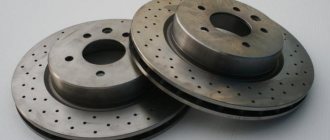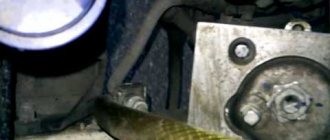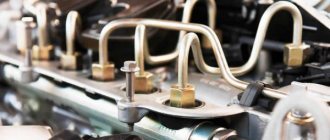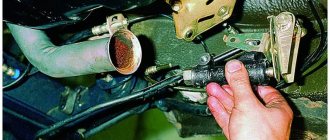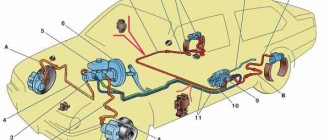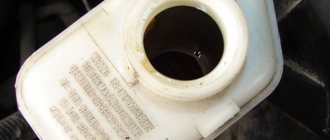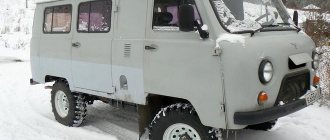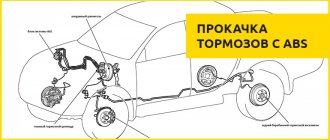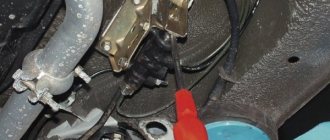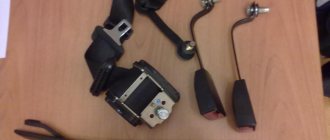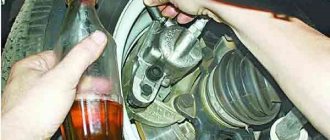Drums, of course, long ago lost the evolutionary war to discs, but to this day they are quite actively used on inexpensive and lightweight machines. All Ladas, Renault Logan, VW Polo sedan, Skoda Rapid, Daewoo Matiz - the list of completely modern models using these archaic but durable brake mechanisms will be very long. This means it’s useful to know how they work, why they break and how they are repaired. After theoretical preparation, we will go to the repair zone, where we will examine the drums of a rare Chinese sedan Chery Jaggi, better known in Russia under the name QQ.
Device
The rear drum brakes are shown in the picture below. This type of brake mechanism has a drum as a rotating element. In the fixed part there is a support shield and pads.
In the figure, elements 1 and 3 are stationary, and element 2 rotates.
This type of brake device includes:
- A drum that is attached to the wheel hub;
- Pads with linings;
- Brake working cylinder, which has 2 pistons with cuffs and boots;
- There is also a fitting screwed into it, with the help of which the liquid is pumped;
- Compression (return) springs that cling to the pads and hold them in the desired position;
- Brake support plate attached to the bridge beam;
- Stand support pads;
- The lower support for the pads with adjustment is an adjustment of the rear pads, allowing you to set the desired gap between the drum and the pad so that the brakes work well and at the same time they do not touch when it is not necessary;
- Brake fluid mechanism;
In addition to standard devices with one cylinder, as in the photo above, there are mechanisms with two cylinders.
Their effectiveness is recognized to be higher than the first option. The principle of operation of drum brakes with two cylinders is the same, only a second cylinder is installed instead of the lower support. In such a mechanism, the surface area of contact between the shoe and the drum is larger, which means the braking is stronger.
Principle of operation
Here's how these devices work: Brake fluid, after the driver presses the brake pedal, flows from the master cylinder to the working cylinders, squeezing out their pistons. These pistons extend and force the pads against the drum. Thereby reducing its rotation and stopping the wheels. This will happen due to friction of the linings on the surface of the drum. After the pressure on the brake pedal stops, the pads are pulled back by springs. And the braking stops. Fluid from the slave cylinders is pushed back into the master cylinder. The wear of the pads will be uneven on the front and rear wheels, which should be taken into account when replacing.
VAZ-2110
Why do brakes squeak and how to get rid of the squeak?
The rear brake drum of the VAZ-2110 can cause problems for the owner during the process of replacement or removal. The part can be dismantled quite simply, provided that the car is new. On older cars, the removal process entails problems. To work, you will need a powerful hammer, a 7 mm deep socket, and a ratchet. The first thing that comes off is the bolts holding the rear wheel. After the car is jacked up, they are finally unscrewed and the wheel is completely removed.
The rear brake drum on Korean cars is removed in the same way (Nexia is no exception). In some cases, it is necessary to use force, but most often, after treating the contact area with WD-40, the drum can be removed perfectly.
Advantages and disadvantages
This device has its pros and cons. Let's start with the cons:
- It has been proven that the braking efficiency of this type of mechanism is slightly lower than that of disc mechanisms. The braking distance is almost 20% longer. This is due to the following reasons: insufficient contact area, which is not provided even by two cylinders, and the resulting slipping, which is caused by dust that has penetrated into the mechanism.
- Overheating of the drums due to lack of cooling; when braking, the temperature of the drums can rise to 6000 degrees.
- A reduced maximum load value, at high pressure, can rupture the drums with liquid pressure.
However, not everything is so bad; there are also undeniable advantages of this mechanism:
- The closed design allows you to get good braking force, and you can increase the friction surface by making the drum wider and the pads too. This is what ensured the widespread use of such a mechanism on all trucks and buses.
- The degree of resistance to wear and the service life of the linings is increased, which is caused by less frictional contact than with a disc brake.
- Good protection against dirt getting inside, which the disk version does not have.
I won’t say whether disc or drum brakes are better; passenger cars mostly have disc brakes, but they are not suitable for buses and trucks.
Production history
And they were invented back in the 19th century. The first prototypes of modern brakes were a primitive system of only three components. This was the brake drum itself, attached to the wheel, a strong and flexible band located around it, as well as a lever that tensioned the last part. Naturally, the service life of such a system was short-lived, and various stones and dirt got into it.
The design was improved only at the beginning of the 20th century. Then engineer Louis Renault invented a new brake drum with more reliable components. For the first time, it included pads located inside the mechanism. The brake device was well protected from dirt, and therefore its service life increased significantly. Since then, the brake drum has repeatedly changed its design and materials, but its function has remained unchanged. Such a device still reduced the vehicle's speed when necessary. It also served as a hand brake.
Differences
How are disc brakes different from drum brakes? The main difference is the braking element; in disc models it is a disc, in drum models it is obviously a drum. The device is also different, the disc brake has a special brake caliper, and the drum brake has a brake cylinder. The pads used are also different. In a drum they expand, pressing against it, but in a disk they compress and clamp the disk. Which works better? To understand this you need to become at least a mechanic or brake tester.
Both mechanisms have their pros and cons, but both are still quite effective, otherwise they would have been abandoned long ago.
Signs of trouble
If these signs appear, you should check the condition of the entire brake system:
- When braking, the vehicle pulls to the side, which means a malfunction of one of the braking mechanisms.
- The creaking of the rear mechanisms can be caused by the separation of the linings from the pads, deformation or breakage of the springs, as a result of which the pads are skewed.
- It is possible for the clamps to jump off the supporting posts; squeaks are caused by them getting between the drum and the pad linings.
- The appearance of jerking or vibration of the pedal when braking is caused by deformation of the drum.
Tips for use
Car care includes periodic inspection of important components and mechanisms of the vehicle. The brake system is one of the most important; its inspection for wear and possible malfunctions is mandatory.
Every 20 thousand km you should check the pads, springs, levers, etc., measure the brake fluid level, check the condition of the cylinders, seals and pipes for integrity and possible leaks.
When installing new pads, experts advise “rolling in” them:
- Find an empty section of road.
- Accelerate to the permitted city speed and slow down to 10 km/h, repeat the acceleration and reduce the speed at least 10 times. At the end of the procedure, drive another 5 km at a calm pace.
Malfunctions
There are seven main problems:
- Worn drum or pads. The most dangerous thing will be the simultaneous wear of these parts, then the wheel can simply block tightly. If there is slight wear on the drum walls, a groove is needed to grind off the sides and level the surface. After this, the pad tension system should be adjusted. They are replaced when:
- For glued ones, the thickness of the friction layer reached 1.6 millimeters.
- For riveted linings, wear reaches 0.8 millimeters from the rivet. Warping of the pads is a fairly common cause of damage to the drum, its uneven grinding, as a result of which it has to be replaced.
- Springs, struts or spacers break.
- Cable rupture or handbrake lever breaking off
- Peeling of linings from pads
- Destruction of the cuff, scuffing of the cylinder, rupture of the hose, depressurization of the pipeline, resulting in fluid leakage from the system and its airing. Brake failures occur.
- Corrosion of springs, resulting in them not working as expected.
To avoid troubles associated with brake system malfunctions, it is recommended:
Check the condition of the linings every 20 thousand mileage, change if necessary; buy a repair kit for the rear pads in the store. Here it is important not to make a mistake with the brand and model, the similarity is confusing, so it is better to have old pads with you for a sample. Pay attention to drips and stains on the ground where your car was parked. Watch the brake fluid level inside the reservoir on the master cylinder.
Drum brake service
Checking the thickness of the brake lining
The wear of the drum brake pads can be determined through a special hole located on the inside of the brake shield. When the friction linings reach a certain thickness, the pads need to be replaced.
If the friction material is applied to the pad using glue, then it is recommended to change it when the material thickness is 1.6 mm. If friction linings are placed on rivets, replacement must be made if the material thickness is 0.8 mm.
Worn pads can leave grooves on the drums and, with prolonged use, even damage the drum.
Replacement with disk
Many experts, including myself, say that replacing drum brakes with disc brakes is associated with a large number of problems:
- The first problem is adapting the hand brake mechanism to the disc mechanism. The design is too different, so connecting the old manual brakes to the new ones will not work. There are two solutions here - either figure out how to remake the old mechanism so that it works, or install a new one. The first option can only be performed by a mechanic with extensive work experience, and not everyone will undertake it. The second option is simpler and more accessible, but its cost is not small. You simply purchase and install a hydraulic handbrake on new mechanisms.
- The second problem is choosing a mechanism suitable for replacement with the required dimensions and to effectively cope with braking. So that there is no difference in diameter or studs. Why buy brakes that won't fit or will work worse than what you had? At the same time, you should not forget to demand quality certificates for purchased mechanisms. This is the only way to be sure that these are reliable branded parts.
- The third problem arises after replacing mechanisms. The fact is that any design changes in the car that affect control and so on must be included in the technical data sheet and the insurance document for the car. This is the only way you can avoid fines and other troubles from the traffic police and misunderstandings among the mechanics who will have to service your car.
- Fourth and most difficult, you may be denied registration of a vehicle if they consider that after modernization the machine no longer meets safety standards or the requirements of operating regulations. Therefore, first find out whether such a change in the design of your car can be registered, and then start thinking about how to change drum brakes to disc brakes.
If you don’t mind your nerves, money and time, you can get started, no one is stopping you.
These are all friends, subscribe to updates if you haven’t already and share the information with your friends via the link, it won’t hurt for them to subscribe either, see you.
Structure of plates
How to bleed brakes on a VAZ 2107
Understanding the structure will help you choose the right discs for your installation.
The structure of an ordinary plate is divided into: a dome (or base, or bell, bell) and a body (bow, “slope”). In the very middle of the dome there is usually a hole necessary for attaching the plate. The body of the cymbal is conventionally divided into a “crash” zone (closer to the edge) and a “ride” zone (closer to the dome) - in accordance with how these types of cymbals are usually played.
There are only three surfaces for the drummer to hit, which determine the sound of the cymbal:
- When playing the dome, the sound is almost bell-like.
- in the ride zone, the sound of the cymbal does not seem to be revealed immediately, so here the sound will be clearer.
- When playing in a crash zone, the cymbal immediately shows its full sound, so clarity is reduced by increasing the power of the sound.
The two main and most obvious parameters that influence the sound of a cymbal are, of course, its size and its weight (thickness).
The size of a plate is its diameter, usually expressed in inches. Large cymbals tend to produce a louder sound, longer sustain (the sound takes longer to decay), and less attack than small cymbals. Dome size also matters: cymbals with larger, more profiled domes produce more overtones (more ringing) and are louder.
Weight (thickness) greatly affects the volume of the sound, clarity/articulation, overall sound and power of the cymbal. Thinner cymbals have a faster attack (because the thin metal vibrates faster) and sound richer. Thin crashes give an explosive and rich sound, but thin rides give more tone and are more likely to “start up”, without giving much clarity. In general, thin cymbals sound better at low or medium volumes. Heavier cymbals have a wider, louder sound; Heavy crashes give more attack and cut better, while heavy hats and rides give crisp, clear articulation so you can hear every hit. Medium plates are a "one size fits all" compromise, but it may be better to have both thin and heavy plates to get the most variety. Conclusion: Heavy cymbals produce greater volume, sustain, and pitch.
The plate profile is another important parameter (see figure above). The higher the profile value, the higher the sound. Low sounds blend well with the music. Higher sounds are harsher and are better suited for loud playing. Conclusion: the higher the profile, the higher the sound, the brighter and more cutting through the sound.
Taper is the degree of reduction in the thickness of the metal from the center to the edge of the cymbal, which determines a more “crash” or more “ride” sound. The thickness of the crash metal smoothly decreases immediately from the center to the edge of the plate, and the thickness of the ride metal is almost the same and disappears only at the very edge of the plate.
The shape of the plate can be very different. The dome is usually in the shape of a cup or nipple, but its size can range from almost unnoticeable to about half the radius of the plate. However, in common types of plates, the dome most often has a bowl shape and a diameter of about 1/5 of the diameter of the plate. The body of the plate can have different shapes, usually depending on the type of plate. The axis of the hole in the dome of the plate is most often round, but there are oval, octagonal and other shapes. The profile of a plate can be absolutely flat, curved, or cone-shaped, but most often it is an ellipsoid (bowl-shaped), like a dome shape, only with a much larger radius of curvature. The edge of the cymbal can also be curved upward (for china cymbals) or downward. In addition, sometimes additional actions are performed on the cymbals in order to influence the sound timbre in one way or another, for example, they make holes, insert rivets or attach metal parts of a different shape, etc. Cymbals are made using casting, turning, forging, pressing, after which they are sometimes minted by machine or by hand. The slightest deviations in the curvature of the metal create mechanical stresses in it, which can seriously affect the sound. The size and location of the forging strikes are quite important: the more varied the distortion of the metal from forging, the richer the sound. Therefore, hand-forged plates are more valued: their location and force of forging blows are more varied and unpredictable.
Alloys for plates come in a wide variety. There are 4 main alloys, each of which is based on copper: bell bronze, malleable bronze, brass and nickel silver, an alloy of copper, zinc and nickel.

